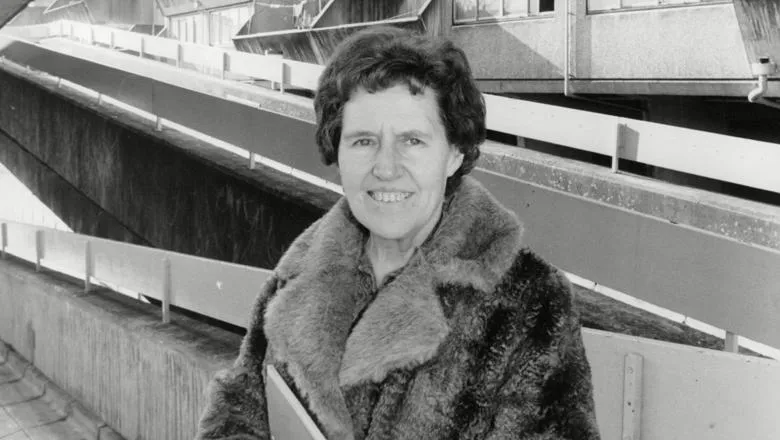Devoted to her job, uncompromising in her standards, a loyal colleague, she was one of the most important geographers of her generation.
Emeritus Professor Denys Brunsden
24 May 2023
Remembering Emerita Professor Alice Coleman
The late Emerita Professor was a pioneer in land use planning and urban regeneration – and had a huge influence on the design of residential developments in the UK.

King’s is saddened to report that Emerita Professor Alice Coleman – a member of the Department of Geography between 1948 and 1988 – passed away on 2 May 2023, just short of her 100th birthday.
Having qualified as a geography teacher and completed her master’s, Alice Coleman was appointed an assistant lecturer at King’s in 1948 – the only qualified teacher on staff in the department at the time. She was later promoted to lecturer in 1951 and became the first female professor in the Department of Geography at King’s in 1987.
She is remembered fondly by the alumni community, particularly for her commitment to field work and field trips – an activity still undertaken by Geography students today. Her interest and early publications on field work were typical of her commitment to a fully rounded geography education that brought physical and human geography together.
She is also celebrated for directing the 1960s Second Land Use Survey of Britain. With a keen interest in cartography and teaching, Professor Coleman set about recruiting geography teachers and sixth formers to compile land use maps of their local area. She, herself, mapped over 1,500 square miles in fifteen different counties.
Three thousand volunteers, together with many of her own students at King’s, helped to map land use across England and Wales, eventually leading to the publication of 120 separate maps.
The immense contribution to understanding the rapidly changing post-war British landscape was recognised by the Royal Geographical Society, which awarded her the Gill Memorial Medal in 1963.
Her concern with planning, a topic that was always present in her work, led to an invitation to advise the newly elected Labour government in 1964. Invitations to lecture and advise governments abroad then followed, and she spent some time in Canada at the University of Western Ontario as the Visiting Professor for Distinguished Women Social Scientists. While in Canada, Professor Coleman produced an important report on Canadian settlements and land use for the Ministry for Urban Affairs – a precursor of her growing interest in urban land use and design that was to define her second main area of research.
On returning to Britain, Professor Coleman turned her attention to the problems of urban decay. In the 1960s and 1970s, de-industrialisation had left large areas of derelict land at the heart of many British cities. The loss of traditional manufacturing jobs had also resulted in high unemployment and deprivation in these places.
A grant from the Joseph Rowntree Foundation in 1979 allowed a Professor Coleman to study the relationships between design and vandalism in housing estates in Southwark and Tower Hamlets. This work led to invitations from other local authorities to advise on their estates.
It also led to her most significant contribution to urban studies, the book Utopia on Trial: vision and reality in planned housing, published in 1985 – and released during the same year as the riots on Broadwater Farm Estate in North London. The book, in which she applied the concept of defensible space and made recommendations for the redesign of public housing, attracted widespread attention, including from King (then Prince) Charles. She also received invitations to advise on the redesign of housing estates in Canada, the Netherlands, Australia and other parts of the world.
In 1987, the Royal Geographical Society awarded Professor Coleman the Busk Medal for innovations in land use analysis and her practical contribution to inner city regeneration.
Her ideas also attracted the attention of Margaret Thatcher, whose administration at the time was struggling to deal with the problems of inner-city crime and urban decay. Thatcher stated in her memoirs that she greatly admired Professor Coleman’s work.
Their relationship laid the basis for the Design Improvement Controlled Experiment (D. I. C. E.), a major project on the redesign of British public housing estates which ran from 1988 to 1994, funded by a £50 million grant from the government.
Following her retirement, Emerita Professor Coleman returned to her other research interest: graphology. In directing the Second Land Use Survey, she had stated that one of the aims was ‘to design maps whose information leapt to the eye spontaneously’ but this was equally true of handwriting, and in the 1990s she honed her expertise on analysing handwriting. Her own handwriting was clear and concise – no word was wasted nor letter over-embellished.
She was particularly keen to pass on her knowledge to her students, be they geography undergraduates, many of whom to this day remember her encouragement to write clearly and concisely, as well as in courses on graphology that she held for members of the University of the Third Age and others. She continued to teach graphology well into her nineties – evidence of a professional life that she began as a teacher and never really left.
